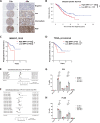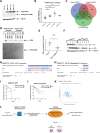BRF1 accelerates prostate tumourigenesis and perturbs immune infiltration
- PMID: 31740786
- PMCID: PMC7033044
- DOI: 10.1038/s41388-019-1106-x
BRF1 accelerates prostate tumourigenesis and perturbs immune infiltration
Erratum in
-
Correction: BRF1 accelerates prostate tumourigenesis and perturbs immune infiltration.Oncogene. 2020 Mar;39(11):2450. doi: 10.1038/s41388-019-1149-z. Oncogene. 2020. PMID: 31857667 Free PMC article.
Abstract
BRF1 is a rate-limiting factor for RNA Polymerase III-mediated transcription and is elevated in numerous cancers. Here, we report that elevated levels of BRF1 associate with poor prognosis in human prostate cancer. In vitro studies in human prostate cancer cell lines demonstrated that transient overexpression of BRF1 increased cell proliferation whereas the transient downregulation of BRF1 reduced proliferation and mediated cell cycle arrest. Consistent with our clinical observations, BRF1 overexpression in a Pten-deficient mouse (PtenΔ/Δ BRF1Tg) prostate cancer model accelerated prostate carcinogenesis and shortened survival. In PtenΔ/Δ BRF1Tg tumours, immune and inflammatory processes were altered, with reduced tumoral infiltration of neutrophils and CD4 positive T cells, which can be explained by decreased levels of complement factor D (CFD) and C7 components of the complement cascade, an innate immune pathway that influences the adaptive immune response. We tested if the secretome was involved in BRF1-driven tumorigenesis. Unbiased proteomic analysis on BRF1-overexpresing PC3 cells confirmed reduced levels of CFD in the secretome, implicating the complement system in prostate carcinogenesis. We further identify that expression of C7 significantly correlates with expression of CD4 and has the potential to alter clinical outcome in human prostate cancer, where low levels of C7 associate with poorer prognosis.
Conflict of interest statement
The authors declare that they have no conflict of interest.
Figures




References
Publication types
MeSH terms
Substances
Grants and funding
LinkOut - more resources
Full Text Sources
Medical
Research Materials
Miscellaneous

